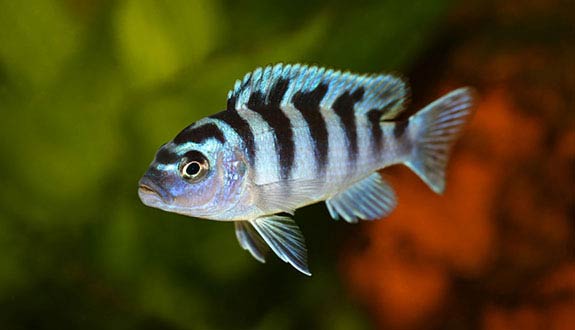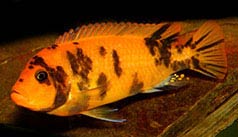

Alternative species (click on the thumbnail to see the card)
Names
Scientific name
Maylandia lombardoi
Common name
Kenyi
Kenyi cichlid
Lombardoi
Kennyi
Origin

Origin: Africa (Lake Malawi)
Biotope: African
Dimorphism
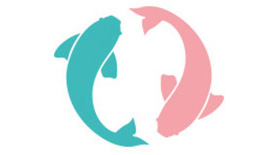
The males are orange and the female is blue
Group
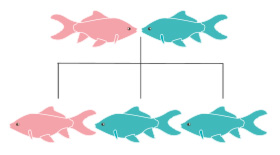
Cichlidae
Volume

300 L / 66 imp gal / 79 US gal
Parameters

T°: 23 to 26°C or 73 to 79°F
pH: 7 to 8
Hardness: 10 to 20°dGH
Difficulty
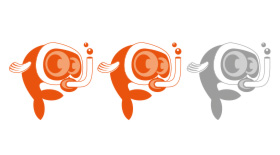
Average
Size
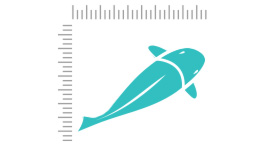
11 to 13 cm (4 to 5")
Longevity
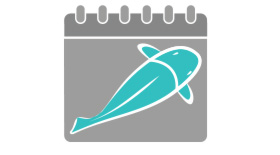
8 years
Living zone

Middle
Individuals
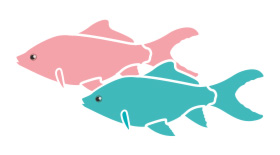
1 male and 2 females
Food
How to feed the Kenyi?
Food
How to feed the Kenyi?
In nature, Maylandia lombardoi is alguivorous: it grazes algae covering rocks and sand.
In aquarium, it will not be too difficult to feed: fresh or dry foods are accepted but with a clear preference for fresh! Reserve a significant proportion of spirulina in your diet.
You can also make homemade mixes of 70% plant and 30% meat. For example, it will enjoy spinach, peas, blanched lettuce, shrimp, krill, artemia.
Remember that as for all African cichlids, worms and Tubifex tubifex are to be banned (they can cause irritation of the digestive system, sometimes leading to the death of fish).
Behavior
What kind of behavior does the Kenyi have?
Behavior
What kind of behavior does the Kenyi have?
Overall, it is a rather lively fish that will animate your aquarium.
Kenyi is very very territorial: it will defend fiercely and with violence its zone of life, in which it does not tolerate any presence. It will be perfectly respectable, even in the face of species deemed territorial. It was sometimes observed that after a few weeks, only the Lombardoi male remained in the aquarium: it cleaned up around him, killing all the other occupants of the aquarium with stress and fatigue! The cohabitation of this species should therefore be very carefully measured and studied (see "cohabitation").
Despite this strong character, it is quite sensitive to stress. A stressed fish will be easily noticed because black lines will appear along its body.
Cohabitation
Who can live with the Kenyi?
Cohabitation
Who can live with the Kenyi?
Because of its quarrelsome temperament, avoid associating the Kenyis with some of the peaceful fish from Malawi, such as the Aulonocara (these cohabitations are however possible in volumes greater than 500/600 liters or 110/132 imp gal or 132/158 US gal). Attention also to cohabitation with Maylandia barlowi and Maylandia estherae because of the risk of hybridization.
Kenyi very much appreciates the presence of its peers. Plan at least a trio. Indeed, an isolated fish will stress and will be more susceptible to diseases. Always plan for a higher number of females.
Breeding
How to breed the Kenyi?
Breeding
How to breed the Kenyi?
During the breeding season, the Maylandia lombardoi will be even more aggressive than usual.
It is polygamous, so you’ll need 1 male for 2 females.
The ideal water parameters for breeding are: temperature at 25°C or 77°F, pH at 8, and hardness at 16°d GH.
During the breeding season, the male will constantly harass the female to form a couple (even killing it sometimes). It is during this period that you will see if the decoration of your aquarium is well arranged: the female must be able to hide easily from the male.
Kenyi is a maternal oral incubator. Once laid and fertilized, the eggs will be collected in the mouth of the female where they will incubate for about 21 days. During this period, the female stops feeding: do not worry, this behavior is normal.
Then it will spit its fry (between 20 and 30). On expulsion, they measure about 1.5 centimeters or 0.4 inches.
Fry food: Frozen cyclops, Artemia nauplies and straws.
Its aquarium
Which aquarium for the Kenyi?
Its aquarium
Which aquarium for the Kenyi?
If you choose to maintain Maylandia lombardoi, choose an aquarium of at least 300 liters (66 imp gal or 79 US gal) for 3 individuals (bare minimum). This aquarium must also have at least 120 centimeters or 47 inches in front.
This fish will readily dig into the soil of the tank. To avoid injury, consider a non-cutting substrate.
To recreate its natural living conditions, place many rocks and stones, which you will pile up to form caves and hiding places. However, be careful with the stability of your decoration so that it does not collapse (you can stick the rocks together for more security).
There is no point in planting your aquarium because your Maylandia lombardoi will take pleasure in uprooting everything every day. Indeed, it digs, moves and destroys its environment until it is to its taste. The only exceptions will be very robust plants such as Anubias for example, which you will fix securely to your decoration.
Because it constantly digs in the sand, pollution can rise quite quickly in an aquarium with Lombardoi. Change between 20 to 25% of the water once a week to ensure clean water.
Good To know
Find all additional information!
Good To know
Find all additional information!
This species is very often available in aquarium stores. However, it can be quite difficult to maintain. Check carefully before adoption, for example by reading this sheet!
This fish is classified as a "vulnerable" species. The main threat is traffic and withdrawal to supply the aquarium trade. Find out where your fish comes from, or adopt it in specialized clubs!
In terms of colours, this species is very unique! In fact, unlike all other cichlids in Lake Malawi, the male is yellow and the female blue. Not to be confused!
Yours photos!
Comments
Sort by:
Please login to post comments
